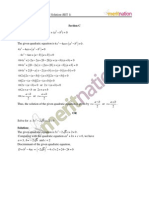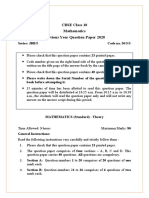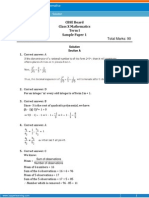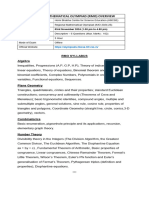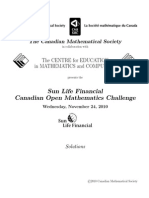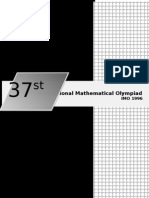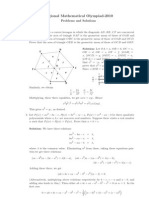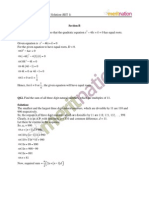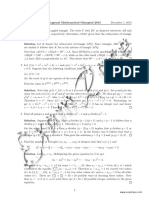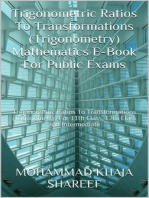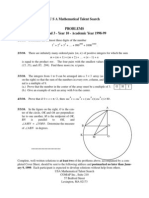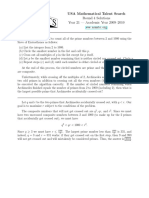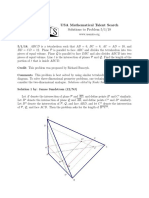Canadian Open Mathematics Challenge: The Canadian Mathematical Society
Uploaded by
สฮาบูดีน สาและCanadian Open Mathematics Challenge: The Canadian Mathematical Society
Uploaded by
สฮาบูดีน สาและThe Canadian Mathematical Society
in collaboration with
The CENTRE for EDUCATION
in MATHEMATICS and COMPUTING
The
Canadian Open
Mathematics Challenge
Wednesday, November 29, 2000
Solutions
2000 Canadian Mathematical Society
2000 COMC Solutions
Part A
1.
An operation is defined by a b = 1
What is the value of (1 2)(3 4) ?
a
, b 0.
b
Solution
By the definition of
1 1
=
2 2
3 1
3 4 = 1 =
4 4
1 2 = 1
1
1
1
2
and so (1 2)(3 4) = = 1 = 1 2 = 1
1
2
4
4
ANSWER:
2.
The sequence 9, 18, 27, 36, 45, 54, consists of successive multiples of 9. This sequence is then altered by
multiplying every other term by 1, starting with the first term, to produce the new sequence
9, 18, 27, 36, 45, 54,... . If the sum of the first n terms of this new sequence is 180, determine n.
Solution
The terms in the sequence are paired, by combining each odd-numbered term with the next term
(that is, we combine terms 1 and 2, 3 and 4, 5 and 6, etc).
The sum of each of these pairs is 9.
So we need 20 of these pairs to reach a sum of 180.
Thus we need 2 20 or 40 terms.
ANSWER:
3.
The symbol n! is used to represent the product n(n 1)(n 2) L(3)(2)(1) .
( )( )( )( )
For example, 4!= 4(3)(2)(1) . Determine n such that n!= 215 36 53 72 (11)(13) .
Solution
Since n! has a prime factor of 13, n must be at least 13.
Since n! has no prime factor of 17, n must be less than 17.
These two facts are true because if m n , then m divides n!.
Since n! has 53 as a factor, then n 15 , since we need n! to have 3 factors which are multiples of 5.
We must thus determine if n = 15 or n = 16.
40
2000 COMC Solutions
So we look at the number of factors of 2 in 16!.
16! gets 1 factor of 2 each from 2, 6, 10, 14
2 factors of 2 each from 4, 12
3 factors of 2 from 8
4 factors of 2 from 16
We have a total of 15 twos which then corresponds to n = 16.
ANSWER:
4.
16
The symbol x means the greatest integer less than or equal to x. For example,
5.7 = 5 , = 3 and 4 = 4 .
Calculate the value of the sum
1 + 2 + 3 + 4 + L +
48 + 49 + 50 .
Solution
We note that for k a positive integer and k 2 n < (k + 1)2 , then k n < k + 1 and so
Thus for 1 n 3, n = 1
n = k.
4 n 8, n = 2
9 n 15, n = 3
etc.
So the sum equals
(1 + 1 + 1) + (2 + 2 + 2 + 2 + 2) + (3 + L + 3) + L + (6 + L + 6) + (7 + 7)
= 3(1) + 5(2) + 7(3) + 9( 4) + 11(5) + 13(6) + 2(7)
= 3 + 10 + 21 + 36 + 55 + 78 + 14
= 217
ANSWER:
5.
217
How many five-digit positive integers have the property that the product of their digits is 2000?
Solution
Let a five-digit number have the form a b c d e where 0 a, b, c, d , e 9, a 0 .
Since the product of the digits is 2000, we must have the product abcde = 2000 = 2 4 53 .
Since the product of the digits is 2000, then 3 of the digits have to be 5. The remaining 2 digits must have a product of
16 or 2 4 .
Thus the two remaining digits must be 4 and 4, or 2 and 8.
2000 COMC Solutions
Possibility 1
Case 1
Using the numbers 5, 5, 5, 4, 4 there are
5!
= 10 possible numbers.
3! 2!
Case 2
Using the numbers 5, 5, 5, 2, 8 there are
5!
= 20 possible numbers.
3!
There are 30 possible such numbers.
OR
Possibility 2
We choose 3 of the 5 positions for the 5s in
5 ways; there are 3 possibilities for the remaining two digits
3
(including order): 2, 8; 4, 4; 8, 2.
5
So there are 3 = 3 10 = 30 possible such 5 digit numbers.
3
ANSWER:
6.
Solve the equation 4 16 sin
)=2
6 sin x
30
, for 0 x 2 .
Solution
We write all factors as powers of 2. Thus
(
2 (2
4 16 sin
4 sin 2 x
2 4 sin
)=2
)=2
x +2
6 sin x
6 sin x
= 2 6 sin x
(*)
Equating exponents (which we can do by taking base 2 logarithms),
4 sin 2 x + 2 = 6 sin x
2 sin 2 x 3 sin x + 1 = 0
(2 sin x 1)(sin x 1) = 0
Therefore, sin x =
1
or sin x = 1.
2
Since 0 x 2 , x =
,
or .
6 6
2
ANSWER:
7.
5
,
,
6 6 2
The sequence of numbers , a3 , a 2 , a1 , a0 , a1 , a2 , a3 , is defined by an (n + 1)a2 n = (n + 3)2 , for all integers n.
Calculate a0 .
2000 COMC Solutions
Solution
Using the given general equation, we note that there are only two choices of n which yield equations containing a2 ,
n = 0 or 2.
i.e.
a0 a2 = 9
from n = 0
a2 3a0 = 25
from n = 2
Adding the first equation to the second, we obtain 2 a0 = 34 , so a0 = 17 .
ANSWER:
8.
In the diagram, ABC is equilateral and the radius of its inscribed circle is 1. A
17
larger circle is drawn through the vertices of the rectangle ABDE .
What is the diameter of the larger circle?
A
Solution
First, we calculate the side length of the equilateral triangle ABC .
Let O be the centre of the smaller circle and P the point of tangency of the circle to
the side AB .
Join OP and OB . Then OPB = 90 by tangency and OBP = 30 by symmetry
since CBA = 60 .
A
O
P
30
Since OP = 1 and BOP is 30-60-90, then OB = 2 and BP = 3 . Thus AB = 2 3 .
Also by symmetry, CO = OB = 2 , so CP = 3.
Since ABDE is a rectangle and CP AB , then AE = 3 .
We now look at the rectangle ABDE and its circumcircle.
Since ABDE is a rectangle, EAB = 90 .
So BE is a diameter.
By Pythagoras,
BE 2 = EA 2 + AB2
( )
= 32 + 2 3
3
A
2 3
= 21
The diameter is
21 .
ANSWER:
21
2000 COMC Solutions
Part B
1.
Triangle ABC has vertices A(0, 0) , B(9, 0) and C(0, 6) . The points P and Q lie on side AB such that AP = PQ = QB .
Similarly, the points R and S lie on side AC so that AR = RS = SC . The vertex C is joined to each of the points P and
Q. In the same way, B is joined to R and S.
(a)
Determine the equation of the line through the points R and B.
(b)
Determine the equation of the line through the points P and C.
(c)
The line segments PC and RB intersect at X, and the line segments QC and SB intersect at Y. Prove that the
points A, X and Y lie on the same straight line.
Solution
Since A(0, 0) , B(9, 0) and AP = PQ = QB , then P has coordinates (3, 0) and Q has coordinates (6, 0) .
Similarly, R is the point (0, 2) and S is the point (0, 4).
(a) Since R is (0, 2) and B is (9, 0), then the slope of RB is m =
20
2
= and so the equation of the line is
09
9
2
( x 0)
9
2
y= x+2
9
y2=
(b) Since P is (3, 0) and C is (0, 6), then the slope of PC is m =
y 0 = 2( x 3)
y = 2x + 6
06
= 2 and so the equation of the line is
3 0
C(0, 6)
(c) First, we determine the coordinates of X.
Equating the lines from (a) and (b), we have
2
9
x + 2 = 2x + 6
16
x=4
9
9
x=
4
S(0, 4)
Y
R(0, 2)
X
A(0, 1) P(3, 0)
Q(6, 0)
3
9 3
9
and substituting into y = 2 x + 6 = 2 + 6 = , so X is the point , .
2
4 2
4
We calculate the equations of the lines QC and SB as in (a) and (b).
06
For QC , slope =
= 1 and so y 0 = 1( x 6) or y = x + 6.
60
4
04
4
4
For SB, slope =
= and so y 0 = ( x 9) or y = x + 4 .
9
9
90
9
So the point Y, which lies at the intersection QC and SB, we obtain by equating these lines
4
9
x + 6 = x + 4
5
x
9
18
x=
5
2=
and so y = x + 6 =
18
12
18 12
+6=
and thus Y is the point , .
5
5
5 5
B(9, 0)
2000 COMC Solutions
3
0 2
9
3
2
= and so is y = x .
Now the line through A(0, 0) and X , has slope m = 29
3
4 2
3
0
4
12 2 18
The point Y lies on this line, as
=
. [This could be done with L.S./R.S. format using equation of line.]
5
3 5
Therefore A, X, Y lie on the same line.
2.
In ABC, the points D, E and F are on sides BC, CA and AB , respectively,
such that AFE = BFD , BDF = CDE , and CED = AEF .
(a)
Prove that BDF = BAC .
(b)
If AB = 5, BC = 8 and CA = 7, determine the length of BD .
E
F
B
Solution
(a) Let AFE = BFD = x
BDF = CDE = y
CED = AEF = z
Thus FAE = 180 x z
A
z
F x
E
z
FBD = 180 x y
ECD = 180 y z
and these 3 angles add to 180 , so
540 2( x + y + z ) = 180
x + y + z = 180
Since FAE + AFE + AEF = 180 (from AEF )
FAE + x + z = x + y + z
FAE = y
Therefore BDF = BAC .
(b) Similarly to part (a), ECD = BFD = x , FBD = CED = z .
BD BA 5 CD CA 7 AE AB 5
=
= ,
=
= ,
=
= .
By equal angles, ABC ~ DBF ~ DEC ~ AEF and so
BF BC 8 CE CB 8 AF AC 7
Therefore, let BD = 5k , BF = 8k , CD = 7l , CE = 8l , AE = 5m , AF = 7m for some k, l, m.
A
Then 5k + 7l = 8 (1)
7m y 5m E
7m + 8k = 5 (2)
x z
z
F
5m + 8l = 7 (3)
8l
x
8k
Determining 7 (3) 5 (1) to eliminate m, we get
56l 40 k = 49 25 = 24
y y
z
x
B
D
C
7l
5k
7l 5k = 3
(4)
5
2
Calculating (1) (4), we get 10 k = 5 or BD = 5k = .
2000 COMC Solutions
3.
(a)
Alphonse and Beryl are playing a game, starting with the geometric shape
shown in Figure 1. Alphonse begins the game by cutting the original shape
into two pieces along one of the lines. He then passes the piece containing
the black triangle to Beryl, and discards the other piece.
Figure 1
Beryl repeats these steps with the piece she receives; that is to say she cuts along the length of a line, passes the
piece containing the black triangle back to Alphonse, and discards the other piece. This process continues, with
the winner being the player who, at the beginning of his or her turn receives only the black triangle. Show, with
justification, that there is always a winning strategy for Beryl.
Solution
We first consider Alphonses possible moves to begin the game. We can assume, without loss of generality, that he cuts
on the left side of the black triangle.
Case 1
Alphonse removes two white triangles, leaving
In this case, Beryl removes only one white triangle, and passes the shape
back to Alphonse, forcing him to
remove the last white triangle and lose.
Case 2
Alphonse removes one white triangle only, leaving
Beryl removes both of the white triangles on the right, leaving Alphonse in the same position as in Case 1 for his
second turn.
Therefore Beryl can always win, regardless of Alphonses strategy.
(b)
Alphonse and Beryl now play a game with the same rules as in (a), except
this time they use the shape in Figure 2 and Beryl goes first. As in (a), cuts
may only be made along the whole length of a line in the figure. Is there a
strategy that Beryl can use to be guaranteed that she will win? (Provide
justification for your answer.)
Figure 2
Solution
We show that, again, Beryl always has a winning strategy.
The strategy is to reduce the shape in Figure 2 to the shape in Figure 1, and to have Alphonse make the first cut at this
stage. Beryl also knows that if she is forced into a position of being the first to cut when Figure 2 is reduced to Figure
1, then Alphonse can force her to lose.
2000 COMC Solutions
9
(9)
We number the lines on the diagram for convenience.
(1)
(8)
(2)
(7)
(3)
(4)
(5)
(6)
We can assume without loss of generality (because of symmetry) that Beryl cuts along (1), (2) or (3) to begin.
If she cuts (2) or (3), then Alphonse cuts the other of these two and leaves Beryl with Figure 1, where she will lose.
Therefore Beryl cuts (1) to begin.
If Alphonse now cuts (2) or (3), Beryl cuts the other of these two and passes the shape in Figure 1 back to Alphonse, and
so he loses.
If Alphonse cuts (8) or (9), Beryl cuts the opposite and passes the shape in Figure 1 to Alphonse, and so he loses.
(Similarly, if he cuts (5) or (6)).
So assume that Alphonse cuts (4) or (7), say (4) by symmetry.
If Beryl now cuts any of (2), (3), (5), (6), (8), or (9), then Alphonse can force Beryl to lose, in the same way as she could
have forced him to lose, as above. So Beryl cuts (7).
Now Alphonse is forced to cut one of (2), (3), (5), (6), (8), or (9), and so Beryl makes the appropriate cut, passing the
shape in Figure 1 back to Alphonse, and so he must lose.
Therefore Beryl always can have a winning strategy.
4.
A sequence t1 , t2 , t3 , ..., tn of n terms is defined as follows:
t1 = 1 , t2 = 4 , and tk = tk 1 + tk 2 for k = 3, 4, ..., n .
Let T be the set of all terms in this sequence; that is, T = {t1 , t2 , t3 , ..., tn } .
(a)
How many positive integers can be expressed as the sum of exactly two distinct elements of the set T ?
Solution
tk > 0 for all k, 1 k n.
Also tk < tk +1 for all k n 1 since tk +1 = tk + tk 1 .
Hence the sequence is monotone increasing.
n
The sum of any pair of terms is an integer and there are pairs.
2
Can any two pairs produce the same integer?
Consider ta + tb and tc + td . Clearly if tb = td then ta = tc and vice versa, implying the same pair.
Hence none of the four terms is equal, so we can assume one term, say td to be the largest.
Then td = td 1 + td 2 ta + tb , since the maximum values of ta and tb are td 1 and td 2 and they cannot be alike.
2000 COMC Solutions
10
n
But since tc > 0 , tc + td > ta + td and there are no two pairs that add to the same integer, so there are exactly integers
2
possible.
(b)
How many positive integers can be expressed as the sum of exactly three distinct elements of the set T ?
Solution
Consider ta + tb + tc and td + te + t f . If any of the first three equals any of the second three we are left with pair
sums of the remaining ones being equal, which is impossible from part (a). Hence there are six unlike terms, and
again we can assume one, say t f , to be the greatest.
It is clearly possible for equality by setting ta and tb equal to t f 1 and t f 2 and then td and te equal to tc1 and
tc2 .
In how many ways can this be done for given f. Clearly, 6 f n , and since 2 < c < f 2 , for any given f there
n
n 4
are f 5 choices for c and the number of ways possible is
( f 5) = 1 + 2 + 3 + L + (n 5) =
.
2
f =6
n n 4
There are a maximum of
possible integers.
3 2
Of these, are any two of like sum?
In ta + tb + tc , the maximal values are t f +1 , t f 3 , and t f 4 , since if one is t f 1 and one t f 2 we revert to the
discussed state. Hence
t a + t b + t c t f 1 + t f 3 + t f 4
= t f 1 + t f 2
= tf .
But td + te + t f > t f .
Hence there are no other triples for which equality of sums exist, and the number of possible integers is
n n 4
.
3 2
You might also like
- Maths Model Test Paper For Summative Assessment - 3100% (1)Maths Model Test Paper For Summative Assessment - 314 pages
- Inmo-2012 Previous Year Question Papers of Indian National Mathematical Olympiad (INMO) With SolutionsNo ratings yetInmo-2012 Previous Year Question Papers of Indian National Mathematical Olympiad (INMO) With Solutions6 pages
- Canadian Open Mathematics Challenge: The Canadian Mathematical SocietyNo ratings yetCanadian Open Mathematics Challenge: The Canadian Mathematical Society13 pages
- Rmo-Sol-2001 Previous Year Question Papers of Regional Mathematical Olympiad With SolutionsNo ratings yetRmo-Sol-2001 Previous Year Question Papers of Regional Mathematical Olympiad With Solutions4 pages
- General Instructions:: CBSE Board Class X Summative Assessment - II Mathematics Board Question Paper 2015No ratings yetGeneral Instructions:: CBSE Board Class X Summative Assessment - II Mathematics Board Question Paper 201523 pages
- Answers and Explanations: Proctored Mock CAT-5 2011No ratings yetAnswers and Explanations: Proctored Mock CAT-5 201110 pages
- HE Assachusetts Ssociation OF Athematics EaguesNo ratings yetHE Assachusetts Ssociation OF Athematics Eagues13 pages
- Section C Q19. Solve For X: 4x SolutionNo ratings yetSection C Q19. Solve For X: 4x Solution12 pages
- CBSE Class 10 Maths Paper Solution 2011No ratings yetCBSE Class 10 Maths Paper Solution 201129 pages
- Regional Mathematical Olympiad-2000 Problems and SolutionsNo ratings yetRegional Mathematical Olympiad-2000 Problems and Solutions4 pages
- 2016 10 Lyp Maths Set 02 Delhi Ans Oieosi1No ratings yet2016 10 Lyp Maths Set 02 Delhi Ans Oieosi119 pages
- CBSE Previous Year Question Papers Class 10 Maths 230730 075651No ratings yetCBSE Previous Year Question Papers Class 10 Maths 230730 075651261 pages
- Time: 3 Hour Total Marks: 90: CBSE Board Class X Mathematics Term I Sample Paper 1No ratings yetTime: 3 Hour Total Marks: 90: CBSE Board Class X Mathematics Term I Sample Paper 115 pages
- Srjmo 2022 Roundtwog 9 G 10 G 11 SolutionsNo ratings yetSrjmo 2022 Roundtwog 9 G 10 G 11 Solutions4 pages
- 2012 Class 10 All India Set-1 Section-CNo ratings yet2012 Class 10 All India Set-1 Section-C13 pages
- Cbse Class 10 Maths Important 1 Mark Questions PDFNo ratings yetCbse Class 10 Maths Important 1 Mark Questions PDF12 pages
- RMO Regional Maths Olympiad Solved Previous Year Question Paper - 2000No ratings yetRMO Regional Maths Olympiad Solved Previous Year Question Paper - 20004 pages
- Regional Mathematical Olympiad-2010: Problems and SolutionsNo ratings yetRegional Mathematical Olympiad-2010: Problems and Solutions4 pages
- Hexagon®: Hanoi Mathematical Olympiad 2012No ratings yetHexagon®: Hanoi Mathematical Olympiad 20127 pages
- Section B Q11. Find The Value(s) of K So That The Quadratic Equation X SolutionNo ratings yetSection B Q11. Find The Value(s) of K So That The Quadratic Equation X Solution7 pages
- Rmo-2010 Previous Year Question Papers of Regional Mathematical Olympiad With SolutionsNo ratings yetRmo-2010 Previous Year Question Papers of Regional Mathematical Olympiad With Solutions4 pages
- Math Majors of America Tournament For High Schools: 2014 Individual Test SolutionsNo ratings yetMath Majors of America Tournament For High Schools: 2014 Individual Test Solutions4 pages
- 2002 Solutions Cayley Contest: Canadian Mathematics CompetitionNo ratings yet2002 Solutions Cayley Contest: Canadian Mathematics Competition9 pages
- Trigonometric Ratios to Transformations (Trigonometry) Mathematics E-Book For Public ExamsFrom EverandTrigonometric Ratios to Transformations (Trigonometry) Mathematics E-Book For Public Exams5/5 (1)
- 10+2 Level Mathematics For All Exams GMAT, GRE, CAT, SAT, ACT, IIT JEE, WBJEE, ISI, CMI, RMO, INMO, KVPY Etc.From Everand10+2 Level Mathematics For All Exams GMAT, GRE, CAT, SAT, ACT, IIT JEE, WBJEE, ISI, CMI, RMO, INMO, KVPY Etc.No ratings yet
- De Moiver's Theorem (Trigonometry) Mathematics Question BankFrom EverandDe Moiver's Theorem (Trigonometry) Mathematics Question BankNo ratings yet
- USA Mathematical Talent Search Round 1 Solutions Year 22 - Academic Year 2010-2011No ratings yetUSA Mathematical Talent Search Round 1 Solutions Year 22 - Academic Year 2010-201115 pages
- U S A Mathematical Talent Search: November 14, 1998No ratings yetU S A Mathematical Talent Search: November 14, 19981 page
- USA Mathematical Talent Search Solutions To Problem 5/4/19: P P P PNo ratings yetUSA Mathematical Talent Search Solutions To Problem 5/4/19: P P P P2 pages
- USA Mathematical Talent Search Round 4 Solutions Year 21 - Academic Year 2009-2010No ratings yetUSA Mathematical Talent Search Round 4 Solutions Year 21 - Academic Year 2009-20107 pages
- U S A Mathematical Talent Search: 1/2/10. Determine The Unique Pair of Real NumbersNo ratings yetU S A Mathematical Talent Search: 1/2/10. Determine The Unique Pair of Real Numbers10 pages
- USA Mathematical Talent Search Solutions To Problem 5/3/17No ratings yetUSA Mathematical Talent Search Solutions To Problem 5/3/175 pages
- U S A Mathematical Talent Search: Later Than September 12, 1998No ratings yetU S A Mathematical Talent Search: Later Than September 12, 19981 page
- USA Mathematical Talent Search Solutions To Problem 4/4/18: Valid Valid Invalid: Loop Invalid: Not ConnectedNo ratings yetUSA Mathematical Talent Search Solutions To Problem 4/4/18: Valid Valid Invalid: Loop Invalid: Not Connected2 pages
- USA Mathematical Talent Search Round 2 Solutions Year 21 - Academic Year 2009-2010No ratings yetUSA Mathematical Talent Search Round 2 Solutions Year 21 - Academic Year 2009-20106 pages
- USA Mathematical Talent Search Solutions To Problem 4/3/16: XX X X XX X XNo ratings yetUSA Mathematical Talent Search Solutions To Problem 4/3/16: XX X X XX X X4 pages
- USA Mathematical Talent Search Solutions To Problem 5/4/18No ratings yetUSA Mathematical Talent Search Solutions To Problem 5/4/183 pages
- USA Mathematical Talent Search Solutions To Problem 5/1/19No ratings yetUSA Mathematical Talent Search Solutions To Problem 5/1/191 page
- USA Mathematical Talent Search Solutions To Problem 5/3/18No ratings yetUSA Mathematical Talent Search Solutions To Problem 5/3/182 pages
- USA Mathematical Talent Search Solutions To Problem 5/3/19No ratings yetUSA Mathematical Talent Search Solutions To Problem 5/3/193 pages
- USA Mathematical Talent Search Round 4 Solutions Year 20 - Academic Year 2008-2009No ratings yetUSA Mathematical Talent Search Round 4 Solutions Year 20 - Academic Year 2008-20097 pages
- USA Mathematical Talent Search Solutions To Problem 5/2/18: D A F ENo ratings yetUSA Mathematical Talent Search Solutions To Problem 5/2/18: D A F E1 page
- USA Mathematical Talent Search Solutions To Problem 5/1/18No ratings yetUSA Mathematical Talent Search Solutions To Problem 5/1/182 pages
- USA Mathematical Talent Search Solutions To Problem 5/1/17No ratings yetUSA Mathematical Talent Search Solutions To Problem 5/1/176 pages
- USA Mathematical Talent Search Solutions To Problem 4/4/19No ratings yetUSA Mathematical Talent Search Solutions To Problem 4/4/192 pages
- USA Mathematical Talent Search Solutions To Problem 4/2/16: Q Q Q Q Q QNo ratings yetUSA Mathematical Talent Search Solutions To Problem 4/2/16: Q Q Q Q Q Q4 pages
- USA Mathematical Talent Search Solutions To Problem 4/4/17No ratings yetUSA Mathematical Talent Search Solutions To Problem 4/4/171 page
- B B at @ B B B B: USA Mathematical Talent Search Solutions To Problem 5/1/16No ratings yetB B at @ B B B B: USA Mathematical Talent Search Solutions To Problem 5/1/166 pages
- USA Mathematical Talent Search Solutions To Problem 4/4/16No ratings yetUSA Mathematical Talent Search Solutions To Problem 4/4/166 pages
- USA Mathematical Talent Search Solutions To Problem 4/3/19: 0 1 2 3 4 4k 4k+1 4k+2 4k+3No ratings yetUSA Mathematical Talent Search Solutions To Problem 4/3/19: 0 1 2 3 4 4k 4k+1 4k+2 4k+31 page
- CEE 306 - Lecture 06 - Mixture Proportion - Fall 2023No ratings yetCEE 306 - Lecture 06 - Mixture Proportion - Fall 202336 pages
- Proof Testing Safety Instrumented Systems: Prasad Goteti May 10, 2018No ratings yetProof Testing Safety Instrumented Systems: Prasad Goteti May 10, 201833 pages
- CD40160BMS, CD40161BMS, CD40162BMS, CD40163BMS: CMOS Synchronous Programmable 4-Bit Counters FeaturesNo ratings yetCD40160BMS, CD40161BMS, CD40162BMS, CD40163BMS: CMOS Synchronous Programmable 4-Bit Counters Features13 pages
- ALSPA Control System Controcad SFC Sequential Language BehaviorNo ratings yetALSPA Control System Controcad SFC Sequential Language Behavior28 pages
- Industrial Minerals in Tasmania - Wollastonite.: Department of Mines - Unpublished Report 1988/29No ratings yetIndustrial Minerals in Tasmania - Wollastonite.: Department of Mines - Unpublished Report 1988/2911 pages
- Full download PROC SQL Beyond the Basics Using SAS Third Edition Kirk Paul Lafler pdf docx100% (4)Full download PROC SQL Beyond the Basics Using SAS Third Edition Kirk Paul Lafler pdf docx65 pages
- IGV, Servos and LVDT - Automation & Control Engineering Forum100% (3)IGV, Servos and LVDT - Automation & Control Engineering Forum1 page
- 21.04.24 - Osr - Star Co-Sc - Jee-Adv - 2023 - P1 - Gta-7 (P2) - Key & Sol100% (1)21.04.24 - Osr - Star Co-Sc - Jee-Adv - 2023 - P1 - Gta-7 (P2) - Key & Sol12 pages
- Dynamic Analysis of Motor Floor: Structure DataNo ratings yetDynamic Analysis of Motor Floor: Structure Data6 pages
- Ground Zero: The Nuclear Demolition of The World Trade CentreNo ratings yetGround Zero: The Nuclear Demolition of The World Trade Centre178 pages
- PVT - Aci Anywhere Deploying Vpod: Technical and Configuration Examples For VpodNo ratings yetPVT - Aci Anywhere Deploying Vpod: Technical and Configuration Examples For Vpod48 pages
- Maths Model Test Paper For Summative Assessment - 3Maths Model Test Paper For Summative Assessment - 3
- Inmo-2012 Previous Year Question Papers of Indian National Mathematical Olympiad (INMO) With SolutionsInmo-2012 Previous Year Question Papers of Indian National Mathematical Olympiad (INMO) With Solutions
- Canadian Open Mathematics Challenge: The Canadian Mathematical SocietyCanadian Open Mathematics Challenge: The Canadian Mathematical Society
- Rmo-Sol-2001 Previous Year Question Papers of Regional Mathematical Olympiad With SolutionsRmo-Sol-2001 Previous Year Question Papers of Regional Mathematical Olympiad With Solutions
- General Instructions:: CBSE Board Class X Summative Assessment - II Mathematics Board Question Paper 2015General Instructions:: CBSE Board Class X Summative Assessment - II Mathematics Board Question Paper 2015
- Answers and Explanations: Proctored Mock CAT-5 2011Answers and Explanations: Proctored Mock CAT-5 2011
- Regional Mathematical Olympiad-2000 Problems and SolutionsRegional Mathematical Olympiad-2000 Problems and Solutions
- CBSE Previous Year Question Papers Class 10 Maths 230730 075651CBSE Previous Year Question Papers Class 10 Maths 230730 075651
- Time: 3 Hour Total Marks: 90: CBSE Board Class X Mathematics Term I Sample Paper 1Time: 3 Hour Total Marks: 90: CBSE Board Class X Mathematics Term I Sample Paper 1
- Cbse Class 10 Maths Important 1 Mark Questions PDFCbse Class 10 Maths Important 1 Mark Questions PDF
- RMO Regional Maths Olympiad Solved Previous Year Question Paper - 2000RMO Regional Maths Olympiad Solved Previous Year Question Paper - 2000
- Regional Mathematical Olympiad-2010: Problems and SolutionsRegional Mathematical Olympiad-2010: Problems and Solutions
- Section B Q11. Find The Value(s) of K So That The Quadratic Equation X SolutionSection B Q11. Find The Value(s) of K So That The Quadratic Equation X Solution
- Rmo-2010 Previous Year Question Papers of Regional Mathematical Olympiad With SolutionsRmo-2010 Previous Year Question Papers of Regional Mathematical Olympiad With Solutions
- Math Majors of America Tournament For High Schools: 2014 Individual Test SolutionsMath Majors of America Tournament For High Schools: 2014 Individual Test Solutions
- 2002 Solutions Cayley Contest: Canadian Mathematics Competition2002 Solutions Cayley Contest: Canadian Mathematics Competition
- Trigonometric Ratios to Transformations (Trigonometry) Mathematics E-Book For Public ExamsFrom EverandTrigonometric Ratios to Transformations (Trigonometry) Mathematics E-Book For Public Exams
- 10+2 Level Mathematics For All Exams GMAT, GRE, CAT, SAT, ACT, IIT JEE, WBJEE, ISI, CMI, RMO, INMO, KVPY Etc.From Everand10+2 Level Mathematics For All Exams GMAT, GRE, CAT, SAT, ACT, IIT JEE, WBJEE, ISI, CMI, RMO, INMO, KVPY Etc.
- De Moiver's Theorem (Trigonometry) Mathematics Question BankFrom EverandDe Moiver's Theorem (Trigonometry) Mathematics Question Bank
- USA Mathematical Talent Search Round 1 Solutions Year 22 - Academic Year 2010-2011USA Mathematical Talent Search Round 1 Solutions Year 22 - Academic Year 2010-2011
- U S A Mathematical Talent Search: November 14, 1998U S A Mathematical Talent Search: November 14, 1998
- USA Mathematical Talent Search Solutions To Problem 5/4/19: P P P PUSA Mathematical Talent Search Solutions To Problem 5/4/19: P P P P
- USA Mathematical Talent Search Round 4 Solutions Year 21 - Academic Year 2009-2010USA Mathematical Talent Search Round 4 Solutions Year 21 - Academic Year 2009-2010
- U S A Mathematical Talent Search: 1/2/10. Determine The Unique Pair of Real NumbersU S A Mathematical Talent Search: 1/2/10. Determine The Unique Pair of Real Numbers
- USA Mathematical Talent Search Solutions To Problem 5/3/17USA Mathematical Talent Search Solutions To Problem 5/3/17
- U S A Mathematical Talent Search: Later Than September 12, 1998U S A Mathematical Talent Search: Later Than September 12, 1998
- USA Mathematical Talent Search Solutions To Problem 4/4/18: Valid Valid Invalid: Loop Invalid: Not ConnectedUSA Mathematical Talent Search Solutions To Problem 4/4/18: Valid Valid Invalid: Loop Invalid: Not Connected
- USA Mathematical Talent Search Round 2 Solutions Year 21 - Academic Year 2009-2010USA Mathematical Talent Search Round 2 Solutions Year 21 - Academic Year 2009-2010
- USA Mathematical Talent Search Solutions To Problem 4/3/16: XX X X XX X XUSA Mathematical Talent Search Solutions To Problem 4/3/16: XX X X XX X X
- USA Mathematical Talent Search Solutions To Problem 5/4/18USA Mathematical Talent Search Solutions To Problem 5/4/18
- USA Mathematical Talent Search Solutions To Problem 5/1/19USA Mathematical Talent Search Solutions To Problem 5/1/19
- USA Mathematical Talent Search Solutions To Problem 5/3/18USA Mathematical Talent Search Solutions To Problem 5/3/18
- USA Mathematical Talent Search Solutions To Problem 5/3/19USA Mathematical Talent Search Solutions To Problem 5/3/19
- USA Mathematical Talent Search Round 4 Solutions Year 20 - Academic Year 2008-2009USA Mathematical Talent Search Round 4 Solutions Year 20 - Academic Year 2008-2009
- USA Mathematical Talent Search Solutions To Problem 5/2/18: D A F EUSA Mathematical Talent Search Solutions To Problem 5/2/18: D A F E
- USA Mathematical Talent Search Solutions To Problem 5/1/18USA Mathematical Talent Search Solutions To Problem 5/1/18
- USA Mathematical Talent Search Solutions To Problem 5/1/17USA Mathematical Talent Search Solutions To Problem 5/1/17
- USA Mathematical Talent Search Solutions To Problem 4/4/19USA Mathematical Talent Search Solutions To Problem 4/4/19
- USA Mathematical Talent Search Solutions To Problem 4/2/16: Q Q Q Q Q QUSA Mathematical Talent Search Solutions To Problem 4/2/16: Q Q Q Q Q Q
- USA Mathematical Talent Search Solutions To Problem 4/4/17USA Mathematical Talent Search Solutions To Problem 4/4/17
- B B at @ B B B B: USA Mathematical Talent Search Solutions To Problem 5/1/16B B at @ B B B B: USA Mathematical Talent Search Solutions To Problem 5/1/16
- USA Mathematical Talent Search Solutions To Problem 4/4/16USA Mathematical Talent Search Solutions To Problem 4/4/16
- USA Mathematical Talent Search Solutions To Problem 4/3/19: 0 1 2 3 4 4k 4k+1 4k+2 4k+3USA Mathematical Talent Search Solutions To Problem 4/3/19: 0 1 2 3 4 4k 4k+1 4k+2 4k+3
- CEE 306 - Lecture 06 - Mixture Proportion - Fall 2023CEE 306 - Lecture 06 - Mixture Proportion - Fall 2023
- Proof Testing Safety Instrumented Systems: Prasad Goteti May 10, 2018Proof Testing Safety Instrumented Systems: Prasad Goteti May 10, 2018
- CD40160BMS, CD40161BMS, CD40162BMS, CD40163BMS: CMOS Synchronous Programmable 4-Bit Counters FeaturesCD40160BMS, CD40161BMS, CD40162BMS, CD40163BMS: CMOS Synchronous Programmable 4-Bit Counters Features
- ALSPA Control System Controcad SFC Sequential Language BehaviorALSPA Control System Controcad SFC Sequential Language Behavior
- Industrial Minerals in Tasmania - Wollastonite.: Department of Mines - Unpublished Report 1988/29Industrial Minerals in Tasmania - Wollastonite.: Department of Mines - Unpublished Report 1988/29
- Full download PROC SQL Beyond the Basics Using SAS Third Edition Kirk Paul Lafler pdf docxFull download PROC SQL Beyond the Basics Using SAS Third Edition Kirk Paul Lafler pdf docx
- IGV, Servos and LVDT - Automation & Control Engineering ForumIGV, Servos and LVDT - Automation & Control Engineering Forum
- 21.04.24 - Osr - Star Co-Sc - Jee-Adv - 2023 - P1 - Gta-7 (P2) - Key & Sol21.04.24 - Osr - Star Co-Sc - Jee-Adv - 2023 - P1 - Gta-7 (P2) - Key & Sol
- Ground Zero: The Nuclear Demolition of The World Trade CentreGround Zero: The Nuclear Demolition of The World Trade Centre
- PVT - Aci Anywhere Deploying Vpod: Technical and Configuration Examples For VpodPVT - Aci Anywhere Deploying Vpod: Technical and Configuration Examples For Vpod






















